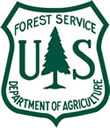An Examination of the Seed Bank and Seed Persistence in a Rhododendron maximum Forest
Riparian forest ecosystems once-dominated by eastern hemlock have undergone fundamental changes in function and composition from infestations of hemlock woolly adelgid (HWA). Eastern hemlock and rosebay rhododendron often co-occur in these riparian forests, with rhododendron forming a dense shrub layer that strongly attenuates light incident on the forest floor, having little to no herbaceous or seedling cover below its canopy, negatively affecting tree seedling densities where they can establish, and decreasing nitrogen availability in the soil and litter layer. Thus, removal of rhododendron may be critical to restoring riparian areas affected by eastern hemlock loss.
Scientists at Coweeta Hydrologic Laboratory (CHL), Southern Research Station, are conducting rhododendron removal experiments in riparian corridors once dominated by eastern hemlock.This involves removing rhododendron subcanopies and litter layers from degraded riparian forests to evaluate the barriers to ecosystem recovery. The experiments are designed to investigate restoration potential and methods in these degraded areas.
As part of this larger study, we plan to investigate the potential contribution of the soil seed bank to regenerating these treated riparian areas. We will assess the quantity and the species richness of the soil seed bank in rhododendron and non-rhododendron plots within the larger study sites. In addition, we would look at seed persistence of rhododendron, as well as dominant woody and herbaceous species in rhododendron and non-rhododendron plots.










